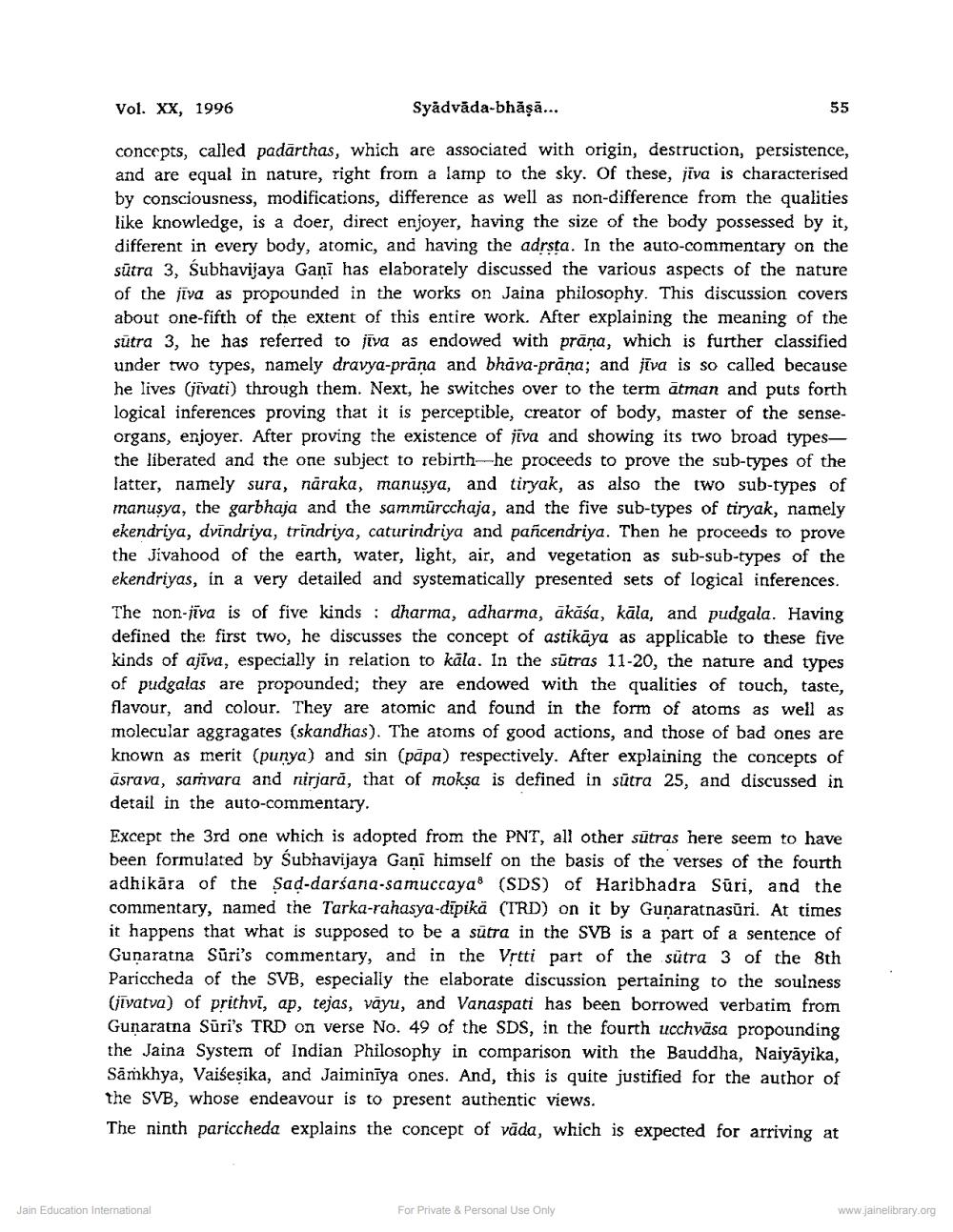________________ Vol. XX, 1996 Syadvada-bhasa... 55 concepts, called padarthas, which are associated with origin, destruction, persistence, and are equal in nature, right from a lamp to the sky. Of these, jiva is characterised by consciousness, modifications, difference as well as non-difference from the qualities like knowledge, is a doer, direct enjoyer, having the size of the body possessed by it, different in every body, atomic, and having the adrsta. In the auto-commentary on the sutra 3, Subhavijaya Gani has elaborarely discussed the various aspects of the nature of the jiva as propounded in the works on Jaina philosophy. This discussion covers about one-fifth of the extent of this entire work. After explaining the meaning of the sutra 3, he has referred to jiva as endowed with prana, which is further classified under two types, namely dravya-prana and bhava-prana; and jiva is so called because he lives (jivati) through them. Next, he switches over to the term atman and puts forth logical inferences proving that it is perceptible, creator of body, master of the senseorgans, enjoyer. After proving the existence of jiva and showing its two broad typesthe liberated and the one subject to rebirth-he proceeds to prove the sub-types of the latter, namely sura, naraka, manusya, and tiryak, as also the two sub-types of manusya, the garbhaja and the sammurcchaja, and the five sub-types of tiryak, namely ekendriya, dvindriya, trindriya, caturindriya and pancendriya. Then he proceeds to prove the Jivahood of the earth, water, light, air, and vegetation as sub-sub-types of the ekendriyas, in a very detailed and systematically presented sets of logical inferences. The non-jiva is of five kinds : dharma, adharma, akasa, kala, and pudgala. Having defined the first two, he discusses the concept of astikaya as applicable to these five kinds of ajiva, especially in relation to kala. In the sutras 11-20, the nature and types of pudgalas are propounded; they are endowed with the qualities of touch, taste, flavour, and colour. They are atomic and found in the form of atoms as well as molecular aggragares (skandhas). The atoms of good actions, and those of bad ones are known as merit (punya) and sin (papa) respectively. After explaining the concepts of asrava, samvara and nirjara, that of moksa is defined in sutra 25, and discussed in detail in the auto-commentary. Except the 3rd one which is adopted from the PNT, all other sutras here seem to have been formulated by Subhavijaya Gani himself on the basis of the verses of the fourth adhikara of the Sad-darsana-samuccaya(r) (SDS) of Haribhadra Suri, and the commentary, named the Tarka-rahasya-dipika (TRD) on it by Gunaratnasuri. At times it happens that what is supposed to be a sutra in the SVB is a part of a sentence of Gunaratna Suri's commentary, and in the Vrtti part of the sutra 3 of the 8th Pariccheda of the SVB, especially the elaborate discussion pertaining to the soulness (jivatva) of prithvi, ap, tejas, vayu, and Vanaspati has been borrowed verbatim from Gunaratna Suris TRD on verse No. 49 of the SDS, in the fourth ucchrasa propounding the Jaina System of Indian Philosophy in comparison with the Bauddha, Naiyayika, Samkhya, Vaisesika, and Jaiminiya ones. And, this is quite justified for the author of the SVB, whose endeavour is to present authentic views. The ninth pariccheda explains the concept of vada, which is expected for arriving at Jain Education International For Private & Personal Use Only www.jainelibrary.org




